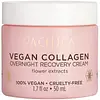What's inside
What's inside
 Key Ingredients
Key Ingredients

 Benefits
Benefits

 Concerns
Concerns

 Ingredients Side-by-side
Ingredients Side-by-side

Water
Skin ConditioningHelianthus Annuus Seed Oil
EmollientGlycerin
HumectantSr-Hydrozoan Polypeptide-1
HumectantCetyl Esters
EmollientGlyceryl Stearate
EmollientCetyl Alcohol
EmollientStearyl Alcohol
EmollientStearic Acid
CleansingTocopheryl Acetate
AntioxidantDiheptyl Succinate
EmollientCapryloyl Glycerin/Sebacic Acid Copolymer
Skin ConditioningMagnesium Ascorbyl Phosphate
AntioxidantCitrus Aurantium Dulcis Flower Extract
Skin ConditioningJasminum Officinale Extract
MaskingChamomilla Recutita Flower Extract
MaskingArnica Montana Extract
Skin ConditioningAllantoin
Skin ConditioningDipotassium Glycyrrhizate
HumectantXanthan Gum
EmulsifyingPhenoxyethanol
PreservativeEthylhexylglycerin
Skin ConditioningParfum
MaskingWater, Helianthus Annuus Seed Oil, Glycerin, Sr-Hydrozoan Polypeptide-1, Cetyl Esters, Glyceryl Stearate, Cetyl Alcohol, Stearyl Alcohol, Stearic Acid, Tocopheryl Acetate, Diheptyl Succinate, Capryloyl Glycerin/Sebacic Acid Copolymer, Magnesium Ascorbyl Phosphate, Citrus Aurantium Dulcis Flower Extract, Jasminum Officinale Extract, Chamomilla Recutita Flower Extract, Arnica Montana Extract, Allantoin, Dipotassium Glycyrrhizate, Xanthan Gum, Phenoxyethanol, Ethylhexylglycerin, Parfum
Water
Skin ConditioningArachis Hypogaea Oil
Skin ConditioningOlus Oil
EmollientGlycerin
HumectantPetrolatum
EmollientTocopheryl Acetate
AntioxidantCetyl Esters
EmollientParaffinum Liquidum
EmollientCera Alba
EmollientZea Mays Oil
EmulsifyingTridecyl Stearate
EmollientC10-30 Cholesterol/Lanosterol Esters
EmulsifyingSodium Borate
BufferingSoluble Collagen
HumectantHydrolyzed Elastin
EmollientPropylene Glycol
HumectantGlyceryl Acrylate/Acrylic Acid Copolymer
HumectantPropylparaben
PreservativeSodium Benzoate
MaskingParfum
MaskingDiazolidinyl Urea
PreservativeMethylparaben
PreservativeTocopherol
AntioxidantRetinyl Palmitate
Skin ConditioningBenzyl Alcohol
PerfumingHexyl Cinnamal
PerfumingHydroxycitronellal
PerfumingBenzyl Benzoate
AntimicrobialBenzyl Salicylate
PerfumingLinalool
PerfumingCitronellol
PerfumingEugenol
PerfumingButylphenyl Methylpropional
PerfumingPotassium Sorbate
PreservativeSodium Chloride
MaskingAlpha-Isomethyl Ionone
PerfumingCI 19140
Cosmetic ColorantCI 42090
Cosmetic ColorantWater, Arachis Hypogaea Oil, Olus Oil, Glycerin, Petrolatum, Tocopheryl Acetate, Cetyl Esters, Paraffinum Liquidum, Cera Alba, Zea Mays Oil, Tridecyl Stearate, C10-30 Cholesterol/Lanosterol Esters, Sodium Borate, Soluble Collagen, Hydrolyzed Elastin, Propylene Glycol, Glyceryl Acrylate/Acrylic Acid Copolymer, Propylparaben, Sodium Benzoate, Parfum, Diazolidinyl Urea, Methylparaben, Tocopherol, Retinyl Palmitate, Benzyl Alcohol, Hexyl Cinnamal, Hydroxycitronellal, Benzyl Benzoate, Benzyl Salicylate, Linalool, Citronellol, Eugenol, Butylphenyl Methylpropional, Potassium Sorbate, Sodium Chloride, Alpha-Isomethyl Ionone, CI 19140, CI 42090
Ingredients Explained
These ingredients are found in both products.
Ingredients higher up in an ingredient list are typically present in a larger amount.
Cetyl Esters is a synthetic wax made up of mostly fatty acids and fatty alcohols. It is strcturally similar to wax taken from whales.
As an emollient, it creates a thin barrier on the skin. This barrier prevents moisture from escaping.
This ingredient may not be fungal-acne safe.
Learn more about Cetyl EstersGlycerin is already naturally found in your skin. It helps moisturize and protect your skin.
A study from 2016 found glycerin to be more effective as a humectant than AHAs and hyaluronic acid.
As a humectant, it helps the skin stay hydrated by pulling moisture to your skin. The low molecular weight of glycerin allows it to pull moisture into the deeper layers of your skin.
Hydrated skin improves your skin barrier; Your skin barrier helps protect against irritants and bacteria.
Glycerin has also been found to have antimicrobial and antiviral properties. Due to these properties, glycerin is often used in wound and burn treatments.
In cosmetics, glycerin is usually derived from plants such as soybean or palm. However, it can also be sourced from animals, such as tallow or animal fat.
This ingredient is organic, colorless, odorless, and non-toxic.
Glycerin is the name for this ingredient in American English. British English uses Glycerol/Glycerine.
Learn more about GlycerinParfum is a catch-all term for an ingredient or more that is used to give a scent to products.
Also called "fragrance", this ingredient can be a blend of hundreds of chemicals or plant oils. This means every product with "fragrance" or "parfum" in the ingredients list is a different mixture.
For instance, Habanolide is a proprietary trade name for a specific aroma chemical. When used as a fragrance ingredient in cosmetics, most aroma chemicals fall under the broad labeling category of “FRAGRANCE” or “PARFUM” according to EU and US regulations.
The term 'parfum' or 'fragrance' is not regulated in many countries. In many cases, it is up to the brand to define this term.
For instance, many brands choose to label themselves as "fragrance-free" because they are not using synthetic fragrances. However, their products may still contain ingredients such as essential oils that are considered a fragrance by INCI standards.
One example is Calendula flower extract. Calendula is an essential oil that still imparts a scent or 'fragrance'.
Depending on the blend, the ingredients in the mixture can cause allergies and sensitivities on the skin. Some ingredients that are known EU allergens include linalool and citronellol.
Parfum can also be used to mask or cover an unpleasant scent.
The bottom line is: not all fragrances/parfum/ingredients are created equally. If you are worried about fragrances, we recommend taking a closer look at an ingredient. And of course, we always recommend speaking with a professional.
Learn more about ParfumTocopheryl Acetate is AKA Vitamin E. It is an antioxidant and protects your skin from free radicals. Free radicals damage the skin by breaking down collagen.
One study found using Tocopheryl Acetate with Vitamin C decreased the number of sunburned cells.
Tocopheryl Acetate is commonly found in both skincare and dietary supplements.
Learn more about Tocopheryl AcetateWater. It's the most common cosmetic ingredient of all. You'll usually see it at the top of ingredient lists, meaning that it makes up the largest part of the product.
So why is it so popular? Water most often acts as a solvent - this means that it helps dissolve other ingredients into the formulation.
You'll also recognize water as that liquid we all need to stay alive. If you see this, drink a glass of water. Stay hydrated!
Learn more about Water